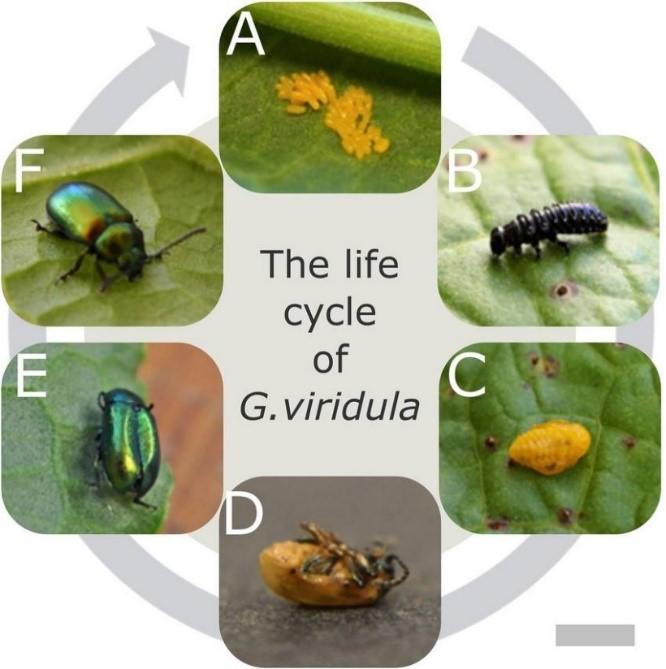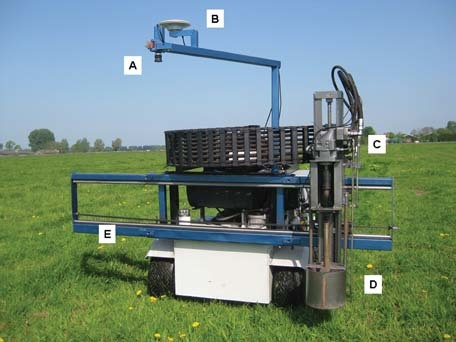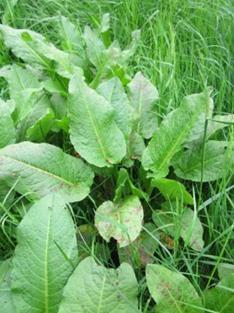Dr Natalie Meades: IBERS, Aberystwyth University.
December 2023
- Docks are perennial weeds that compete with forages of nutritional importance for livestock production. A heavy presence of docks within pastures and grasslands can be problematic where they can reduce forage productivity and devalue the nutritional value of swards.
- Due to the physical characteristics of the dock, it is particularly challenging to eradicate and control them within pastures and grassland systems.
- Strategies to control and eliminate weeds such as docks have traditionally involved the use of chemical-based herbicides. However, these are expensive and have been demonstrated to have negative effects on the environment and human health. Therefore, there is requirement to reduce reliance on herbicides and find sustainable non-chemical alternatives. One strategy is Integrated Pest Management (IPM).
Docks
Broad leaf (Rumex obtusifolius L.) and curled leaf (Rumex crispus) docks, are perennial weeds that grow in pastures and grasslands within the UK. Docks grow well in high nitrogen, humus-rich clay or loam soils and have a high preference for growing in compact and damp soil. It is therefore common to see docks growing on land that has been disturbed such as, bare soil caused by poaching or following drought periods. Therefore, docks typically grow within gateways, headlands and ditches. In addition, docks are particularly common in grassland management systems where inorganic and organic fertilizer use is high and where grass silage has been produced intensively.
If left uncontrolled, docks can reduce grass productivity by 10 - 40% where they compete with forages of nutritional importance to livestock production for nutrients, water, light and space. Furthermore, docks have a lower nutritional value in comparison to forages commonly fed to livestock and are extremely unpalatable and will only be eaten when forage is in deficit. Moreover, they can be detrimental to ruminant health if consumed in excess. This is due to the plant producing secondary metabolites such as oxalates as part of their defence mechanism. As such there is need to control docks on farm.
Docks are challenging to control and very difficult to remove from pasture and grasslands, this is owed to their physical characteristics. Mature docks have a crown structure and deep tap roots that can grow to approximately 2m in length. This allows the plant to access nutrients within the soil that plants with shallow roots may not have access to. Moreover, the tap root has the capacity to store nutrients which can support growth after damage and give rise to new plants. Likewise, a mature dock plant has been reported to have the capability of producing up to 60,000 seeds per year, that can survive within the soil for up to 25 years. These seeds can easily be spread onto pasture via the wind, water and by animals and thus establish in places far from their origin.
Herbicide Use
Docks are regarded as weeds and can therefore be categorised as a pest on farms. Typical treatment of pests has included the use of pesticides. Pesticides are a group of chemical-based plant protection products (PPP) that are used to control and eradicate pests, disease and weeds. Farmers are regarded as professional users of pesticides, therefore there are certain rules and regulations that need to be followed regarding their use under the Official Controls (Plant Protection Products) regulations 2020.
Within the pesticide group are herbicides which are specifically used to control weeds. Whilst herbicides have been demonstrated to have positive effects in controlling and eliminating weeds within pasture and grassland systems, they are expensive and there are many concerns regarding their use. One major concern is the effect of herbicides on the wider environment, where herbicides can pollute surface and groundwaters and can be toxic to certain aquatic life and invertebrates. As such, restrictions on use have been put in place to protect the environment, such as not spraying where rainfall and heavy winds are forecast and creating 5m (minimum) buffer zones to protect water courses. Moreover, the use of chemical herbicides may also have negative effects on other plant species within swards. It has been demonstrated that commercially available herbicides for tackling docks such as, Doxstar (Triclopyr + Fluroxypyr), Forefront T (Aminopyralid + Triclopyr), Starane2 (1-methyl heptyl ester + Fluroxypyr), Binder (1-methyl heptyl ester + Fluroxypyr), Hurler (Fluroxypyr), and Pastor Trio (Triclopyr Tor+ Fluroxypyr) can have negative effects on clover within swards. Likewise, a grassland weed control guide produced in Ireland in 2016 reported certain herbicides such as Prospect (Thifensulfuron-Methyl) to have the effect of stunting grass growth under certain circumstances. Furthermore, certain chemicals within herbicides are toxic and therefore classified as hazardous to human health, it is therefore essential that Control of Substances Hazardous to Health (COSHH) regulations are adhered to when handling and using such chemicals. With all of this in mind, it is not surprising that current advice on herbicide use is to only use when other weed control options are not possible or have failed. Moreover, where herbicide use is required, there is encouragement to use precision application methods such as spot spraying or weed wiping.
Integrated Pest Management
There is drive to minimise herbicide use within agricultural systems and to adopt more sustainable strategies. One proposed strategy is Integrated Pest Management (IPM). Where IPM can be defined as the combination of different non-chemical control strategies to detect, prevent and control weeds whilst minimising chemical pesticide use. A previous technical article describes various non-chemical weed control strategies. However, for the remainder of this technical article focus will be given to the use of non-chemical weed control strategies for controlling docks in pasture and grasslands within Wales.
Biological Control
Biological weed control involving the use of insects can be seen as an attractive non-chemical strategy for controlling dock populations. The green dock leaf beetle (Gastrophysa viridula) here otherwise referred to as beetle, is a species of beetle native to Europe that predominantly favours humid environments and is commonly found living and feeding on certain plants along shorelines, in pastures and on roadsides within the UK. It is distinguishable from other beetles within the ecosystems by its metallic green appearance and brightly coloured yellow eggs (Figure 1).
The dietary habit of the beetle is described as oligophagous, as such they graze a select number of plants including docks, sorrels, buckwheat, knotweed, knotgrass and rhubarb, to name a few. Moreover, the radius in which adult beetles travel is limited to < 10m and they have rarely been observed to fly. Therefore, these beetles can be seen as an attractive alternative to chemical-based herbicides for controlling docks in pasture and grassland environments. Even better still, the beetles naturally live within pastures and grasslands within Wales. It is therefore important that these beetles are encouraged to reside within ecosystems.
The typical life cycle of the beetle can be categorised into the following stages; egg, three larval stages, pupa and imago as described in Figure 1. Briefly, adult beetles hibernate at a depth of 3-8 cm in the soil before emerging to copulate late spring/ early summer (April/ May). Eggs are deposited by adult females on the abaxial side of the dock leaf in clutches, with around 35-40 eggs within a clutch. Larvae within a clutch emerge together first consuming empty chorions before consuming the host plant’s leaves. Larvae continue to feed from the leaves, after which the larvae make their way into the soil and pupate at a depth of 2-5 cm within self-made pupation chambers. Following pupation, the adult beetle emerges and begins to feed on the dock’s leaves, with females depositing eggs on the abaxial surface of the leaf almost immediately after mating. It is expected that a beetle will complete 3 - 4 generations per year.

|
Figure 1: The lifecycle of the green dock leaf beetle (Gastrophysa viridula) with approximate days of development from an egg to an adult. Where A) represents the egg (day 0-7), B) represents the larval stages (days 8-18), C) represents the pupa (days 18-25), D) represents after ecdysis (day 25), E) represents the final cuticle expansion (day 26) and F) represents the adult beetle. Image and description by Onelli, et al. (2017). |
The beetle causes damage to the docks by grazing large areas of their leaves causing deformation and defoliation which leads to the weakening of the plant and therefore reduces the efficiency of plant development and regrowth in following growing seasons. Under controlled experimental conditions a study observed docks treated with a low (25 newly hatched larvae) or high (75 newly hatched larvae) application rate of beetles to result in 20 - 40% and 50 - 70% leaf loss respectively. The potential level of destruction caused by beetles is thought to be related to the nutritional composition of the dock leaves. It has been observed that beetles consuming younger leaves have higher survival rates in comparison to beetles consuming older mature leaves post seed production, as a result of leaf quality and quantity. As such topping plants and allowing for regrowth may help to increase beetle herbivory through increased nutrient availability. However, the timing of this is important regarding the prevention of seed dispersion.
In addition to the defoliation and deformation of dock leaves, these beetles have been demonstrated to have negative effects on seed production and quality. Under controlled experimental conditions in the field, a study observed dock leaf plants populated with the dock leaf beetle to produce fewer seeds and to have lower seed weights in comparison to non-populated plants. As such, it seems as if these beetles act by hindering the efficiency of plant production. However, it must be emphasised that the beetles rarely have the effect of killing the plant directly.
Electrophysical Destruction
The use of electricity has been proposed as an alternative to the use of chemical herbicides. This either involves electricity being supplied to plants either as spark treatments or through continuous contact. Spark treatment involves electricity passing to the plant at a high voltage for short duration pulses (e.g. 25-60 kV, 1-3 μs) and continuous contact consists of an electrode connected to a high voltage source (e.g. 15 kV, 54 kW). As such, a current flows through the plant and damages plant tissues. A European Innovation Partnership (EIP) Wales project looked into the effectiveness of an electric weeding machine known as RootWave Pro to control docks on two dairy farms in South Wales (Figure. 2). The results of the project demonstrated the electrophysical destruction of the dock plants at three time points to have positive results with regards to dock control and were described to be comparable to the control herbicide treatment. Adoption of this technology has been limited regarding the health and safety of using high voltages and the additional energy required to power such technology. However, with technology evolving and continually developing, the emergence of this technology for use on commercial farms may be more common in the near future.

|
Figure 2: Example of a handheld electric weeding machine. Image by Farming Connect. |
Mechanical Methods
Mechanical control in the form of pulling weeds from the ground is another non-chemical-based control method. Docks can either be pulled from the ground by hand or by machine. Hand pulling of docks is labour intensive and not practical on a large scale. However, mechanical means such as rotavating and ploughing is much more achievable. However, care must be taken when pulling docks from the ground, considering that docks can re-grow from root fragments that have been left behind in the soil. Likewise, following ploughing care needs to be taken with regards to any dock seeds that may be lying dormant within the soil.
Cutting dock leaves is another form of mechanical control. It has been demonstrated the more frequently docks are cut, the more damage that occurs to the plant. Cutting plants 3 - 4 times per year has been demonstrated to reduce the abundance of docks by 40%, whereas cutting docks 5-7 times per year has been shown to reduce abundance by 60%. As such, it is recommended that docks are cut every 2 weeks. Likewise, it has been demonstrated that a high intensity of cutting can result in a decrease in storage carbohydrates within tap roots.
As with hand pulling cutting docks is labour intensive. However, there are new technologies emerging such as the use of robots that can detect and destroy plants without human intervention. A study investigated the use of a prototype robot to navigate pasture, detect docks via a camera and remove them by drilling into the soil and destroying both the plant and tap root via cutting (Figure. 3). The results of the study showed promising results with the robot detecting up to 93% of docks within the test pasture and having an effectiveness of 75%.

|
Figure 3: A robot that can detect docks and destroy them. A) represents a boom mounted camera, B) GPS antenna, C) Hydraulic motor for the weeder, D) the weeder and E) the rail that allows for the lateral movement of the weeder Image and description by van Evert, et al. (2011). |
Cultural Control
Cultural control is another non-chemical control method and involves the prevention of docks on farm through good pasture and grassland management. A technical article produced in Ireland highlights the importance of this and that having healthy soils that are conducive for the growth of dense, leafy grass swards are beneficial for preventing the emergence of new docks within pastures. Likewise, the article emphasises the importance of grazing management, suggesting that tight grazing and grazing that will induce poaching will leave pasture open and as such provide suitable environments for docks to establish in. Moreover, it has been demonstrated that the repeated cutting of silage and application of slurry to grassland can lead to an increase in dock emergence. This is thought to be due to increased exposure of the soil for dock seeds to establish in. Moreover, potassium (K) within slurry has been demonstrated to promote dock growth. As such, it is recommended that silage fields are regularly rotated.
Summary
Broad leaf (Rumex obtusifolius L.) and curled leaf (Rumex crispus) docks are perennial weeds that compete with forages of nutritional importance for livestock production. Heavy infestations of docks within pastures and grasslands can reduce forage productivity and decrease the nutritional value of swards. As such it is important that strategies are put in place to prevent and control docks on farm. Herbicides have traditionally been used to control docks; however, they are expensive and there is concern regarding the negative effects of herbicides on the environment and on human health. As such, there is drive to minimise their use. One strategy is Integrated Pest Management (IPM) which involves a range of non-chemical control strategies to detect, prevent and control weeds. This still means that chemical herbicides can be used but following the use of non-chemical control strategies first, herbicide use should be much less and therefore minimised.



